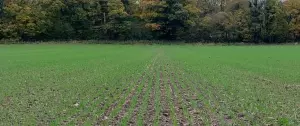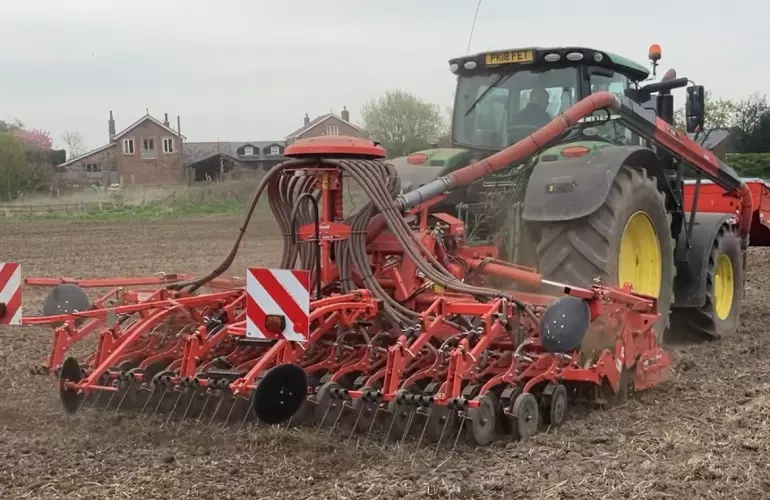Front tank combi offers vital drilling flexibility
The farm, in Rainford near St Helens, Merseyside, ran an existing 3m combi that didn’t provide the required output for the arable cropping area, with a comfortable 25ha/day being the minimum requirement. The farm needed one drill for all soils, which meant it still required something that could breakdown ploughed land. This eventually led them to purchase a new 4m Kuhn HR 4004 power harrow with BTFR 4000 seeding bar and opt for a Kuhn TF 1512 front tank for several reasons.

A modern front tank and combination drill is offering one user extra capacity, reduced compaction, and healthier crops, with the flexibility to operate in tricky conditions.
Moving to a minimum tillage system, and ploughing one in every four years, was a catalyst for the Birchalls to revaluate what drill would best suit their operations.
“We initially wanted a trailed drill, which would offer us the increased output we craved,” says Ian Birchall, who farms in partnership with his brother, David. “However, after demoing 6m versions of the Kuhn Espro and Horsch Pronto, we liked the finish but were unconvinced that the trailed configuration would provide the flexibility to drill in less-than-ideal conditions.”
The farm, in Rainford near St Helens, Merseyside, ran an existing 3m combi that didn’t provide the required output for the arable cropping area, with a comfortable 25ha/day being the minimum requirement. The farm needed one drill for all soils, which meant it still required something that could breakdown ploughed land. This eventually led them to purchase a new 4m Kuhn HR 4004 power harrow with BTFR 4000 seeding bar and opt for a Kuhn TF 1512 front tank for several reasons.
“We thought hard about the system and, once we realised a trailed drill wouldn’t work, we reverted to the combi combined with the front tank, as it allowed us the same capacity as the two drills we demoed, but the versatility to deal with all seedbeds and conditions.”
As the Birchalls planned to use the drill on min-till land that had received one pass from a Rabe Combimix cultivator, they choose wider row spacings to increase the distance between Seedflex counters for trash to move through the drill.
Front tank flexibility
The drill arrived in October 2022 and the purchase of the TF 1512 was the first time the farm had used a front tank. However, across the first two seasons, it not only provided them with the drilling flexibility, but offers the business more options going forward.
“The front tank has futureproofed us in several ways. We can use it on multiple machines, including other branded implements. For instance, we could easily put a distribution head on our cultivator and use the front tank to supply it, or switch the tank to feed fertiliser to a drill on the rear. It offers us options we didn’t have before.”

By removing the weight from the rear of the tractor, the Birchalls were able to spec a wider Kuhn 4004 folding power harrow and matching BTFR seeding unit. They wanted to avoid a rigid machine due to complications it could present with road transport, and, although the front tank is a long outfit, the even weight distribution is a benefit in the field.
“The front tank is 2,000-litres, which easily holds three and a half 500kg bags of wheat seed to supply us for most of the day. However, the biggest advantage is the weight distribution from front to back. The tank counteracts the weight of the power harrow and BTFR, so compaction is reduced, and we can get on the fields quicker due to the combined weight being distributed evenly ensuring it only leaves a light footprint.”
When ordering the tank, the Birchalls had the option to go for press wheels to support the weight, but this would’ve had a negative impact on the even weight distribution and the full width wouldn’t be covered by the wheels, as Ian explains.
“The TF’s optional press wheels only pressed in the centre of the tractor’s wheelings, which meant there would be unpressed strips each side. We wanted to ensure that the seed emergence was consistent across the full drill width so opted to carry the front tank on the link arms.”
Another useful advantage from the combination has been the ability to ballast the tractor more effectively to reduce compaction. The Birchalls can now apply extra weight to specific areas, rather than adding ballast at the front to correct the weight of a rear implement, to achieve the optimum traction and reduced compaction.
Setting up the tank
The Birchalls have owned a Kuhn Axis fertiliser spreader for several decades and have always been impressed with the accurate metering on the machine. This was a big factor in choosing a Kuhn drill, as the drills metering system is also manufactured at the same factory. The backup from local dealer Malpas Tractors was also key.
Calibration is simple with one roller for all seed sizes. The operator selects the pre-saved crop in the display which offers a rough density. Once the desired application rate has been entered, a couple of calibrations are required via the push button on the side of the drill, and the machine calculates the size of the opening for the target rate. Ian says this has reduced calibration times significantly.
“We can now calibrate a new seed in five minutes, whereas this was more like 20 minutes with our old 3m combi. The machine also saves previous settings, so if we return to a seed we have already calibrated, we select the variety in the seed list and the machine remembers the settings. It is also much safer, as there is no climbing over the drill to fill up and calibrate.”
In the field, the TF has an automatic work mode alongside the tractor’s implement management system making controls very simple. The TF 1512 can also be set up to work with wider implements, as a simple setting to change the width allows the tank to meter the right amount of seed to match.

Wider row spacings
Choosing the wider 150mm row spacings, replacing the standard 125mm widths, has reduced the number of outlets across the drill and increased the room for chopped straw and soil to pass through. This has big benefits when drilling in wetter conditions and allows the farm to get on the land earlier after bad weather, while the clearance between the power harrow roller to the first disc aids trash flow.
There are five fewer outlets – 27 rows instead of 32 rows – which Ian says not only has operational benefits thanks to a lower overall weight and horsepower requirement, but it has improved crop emergence as well.
“We’ve seen much better tillering from crops due to the wider gaps between the rows offering the plants additional light and space. Another benefit has been an even emergence. We aren’t getting patches of fields ahead of others as the seeding depth remains consistent across the width. The Seedflex disc coulters are mounted on a parallelogram linkage and the following press wheels have helped with seed to soil contact.”
Setting the depth of the power harrow tines is still manual via pin adjustment as hydraulic wasn’t available at the time, although coulter depth is set hydraulically via removable shims. The tines are set to just tickle the surface when on min-till land to eradicate tractor wheel marks, and, in ideal conditions, a comfortable 3.7-4ha/hour is possible.
The combination has allowed the farm to retain flexibility of its drilling throughout the year, and the addition of front tank has provided the output of a trailed drill, with the versatility to cope with a wide range of soil types, as Ian concludes:
“We have been surprised how flexible the front tank has been and how many smaller benefits it has offered us as a business. I don’t see a reason to consider a trailed drill in the future now we have the front tank.”
